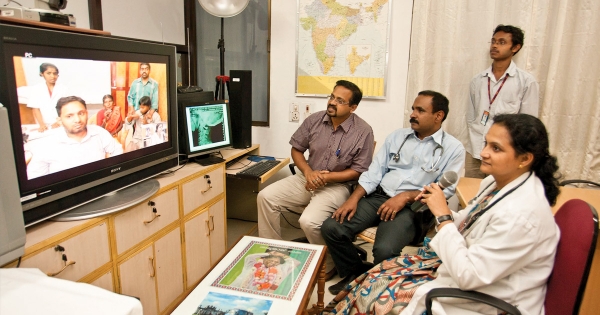Dr Mohanan Kunnummal, Vice-Chancellor of the Kerala University of Health Sciences, inaugurated the event. In his opening address, he said telemedicine has legal protection across India, and with the shift to 5G, it will become widely popular. The advancement of technology and network connectivity will open even better possibilities, and many modern tools will have a decisive impact, especially virtual and augmented reality. He observed: “The new technologies will help create the impression of getting tested sitting next to the patient.”
Dr Prem Nair is the Group Medical Director of Amrita Hospitals, the President of TSI’s Kerala Chapter, and Chairman of Telemedicon 2022. In his introductory speech, he emphasized how telemedicine could help bring down the cost of health care. He noted that 5G connectivity will strengthen the telemedicine system across the country, reducing the time it takes to save the lives of critically ill patients. It can also be effectively used in cases where a patient is using a wearable medical device.
“We are one of the early adopters of telemedicine in the state of Kerala. It primarily started as a programme to bridge the physical distance between care providers and patients. Now we are making use of state-of-the-art technologies to expand telemedicine services,” said Dr Nair.
He explained that Amrita Hospital’s telemedicine unit started in 2002 in partnership with the Indian Space Research Organisation (ISRO) to access satellite technology for communications. Now, mobile phones have created a vast expanse of reach to people in their everyday lives.
“Our expertise, clinical care, technology research, and social commitment help us deliver technology-enabled care. When we started our activity in Kerala in association with the ISRO, we aimed to provide early healthcare services at an affordable cost. Today, we provide telemedicine services to 60 national and nine international centres.”
ISRO Chairman S Somnath attended the conference virtually. He explained the steps taken by ISRO in the initial phase of telemedicine and that the sector will witness revolutionary changes as connectivity facilities further improve. Especially through as satellites spread, access to telemedicine can be strengthened and services expanded in rural areas. He pointed out that there will also be significant changes in healthcare services with the increasing development of applications.
Kerala IT Secretary Dr Ratan Kelkar said in his address to the gathering: “Start-ups, private entrepreneurs, and technology partners should come forward to promote telemedicine. Greater participation is essential for the sector's growth as 5G has provided the best background.”
In addition, Dr PK Pradhan, President, TSI; Sri MG Bijoy, Telemedicon Organising Secretary; and Dr Murthy Remilla, TSI Secretary were among the dignitaries who addressed the inaugural function.
During the conference, Prof Vidya Ramkumar with Sri Ramachandra University, Chennai spoke about the vital need to ensure telemedicine for the rural masses. With a PhD in Audiology and Speech, Language Pathology, she has focused on the potential for telemedicine and emphasised its reach to remote areas is the core aim of such facilities.
New guidelines related to telehealth services were announced online at the conference by WHO representatives. As well, India’s Lt Gen RM Gupta and Commodore Ajit Gopinath spoke on the topic of using telemedicine in the country’s defence sector. Experts also discussed a wide variety of topics, including the possibilities for artificial intelligence in the field of health and how remote monitoring systems were used in the COVID-19 pandemic.
At the valedictory function, Kerala State Tourism Secretary KS Srinivas was the Chief Guest. New office-bearers of the Telemedicine Society of India for the coming year took charge of their roles and included: Dr Meenu Singh, Executive Director, All India Institute of Medical Sciences (AIIMS), Rishikesh as TSI President; Dr Prem Nair as TSI Vice President; and Dr Murthy Remilla, ISRO as TSI Hon Secretary.
Photo 1: Amrita Hospital’s telemedicine unit started in 2002 in partnership with the Indian Space Research Organization (ISRO) to access satellite technology for communications.
Photo 2: Dr Prem Nair emphasized 5G connectivity will strengthen telemedicine system and reduce the time it takes to save the lives of critically ill patients.
Photo 3: Members of the Telemedicine Society of India especially assessed how to ensure the reach of its services to rural and remote areas.







